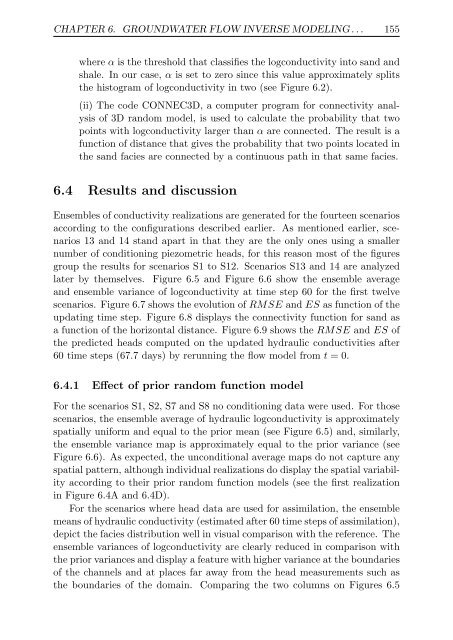Upscaling and Inverse Modeling of Groundwater Flow and Mass ...
Upscaling and Inverse Modeling of Groundwater Flow and Mass ...
Upscaling and Inverse Modeling of Groundwater Flow and Mass ...
Create successful ePaper yourself
Turn your PDF publications into a flip-book with our unique Google optimized e-Paper software.
CHAPTER 6. GROUNDWATER FLOW INVERSE MODELING . . . 155<br />
where α is the threshold that classifies the logconductivity into s<strong>and</strong> <strong>and</strong><br />
shale. In our case, α is set to zero since this value approximately splits<br />
the histogram <strong>of</strong> logconductivity in two (see Figure 6.2).<br />
(ii) The code CONNEC3D, a computer program for connectivity analysis<br />
<strong>of</strong> 3D r<strong>and</strong>om model, is used to calculate the probability that two<br />
points with logconductivity larger than α are connected. The result is a<br />
function <strong>of</strong> distance that gives the probability that two points located in<br />
the s<strong>and</strong> facies are connected by a continuous path in that same facies.<br />
6.4 Results <strong>and</strong> discussion<br />
Ensembles <strong>of</strong> conductivity realizations are generated for the fourteen scenarios<br />
according to the configurations described earlier. As mentioned earlier, scenarios<br />
13 <strong>and</strong> 14 st<strong>and</strong> apart in that they are the only ones using a smaller<br />
number <strong>of</strong> conditioning piezometric heads, for this reason most <strong>of</strong> the figures<br />
group the results for scenarios S1 to S12. Scenarios S13 <strong>and</strong> 14 are analyzed<br />
later by themselves. Figure 6.5 <strong>and</strong> Figure 6.6 show the ensemble average<br />
<strong>and</strong> ensemble variance <strong>of</strong> logconductivity at time step 60 for the first twelve<br />
scenarios. Figure 6.7 shows the evolution <strong>of</strong> RMSE <strong>and</strong> ES as function <strong>of</strong> the<br />
updating time step. Figure 6.8 displays the connectivity function for s<strong>and</strong> as<br />
a function <strong>of</strong> the horizontal distance. Figure 6.9 shows the RMSE <strong>and</strong> ES <strong>of</strong><br />
the predicted heads computed on the updated hydraulic conductivities after<br />
60 time steps (67.7 days) by rerunning the flow model from t = 0.<br />
6.4.1 Effect <strong>of</strong> prior r<strong>and</strong>om function model<br />
For the scenarios S1, S2, S7 <strong>and</strong> S8 no conditioning data were used. For those<br />
scenarios, the ensemble average <strong>of</strong> hydraulic logconductivity is approximately<br />
spatially uniform <strong>and</strong> equal to the prior mean (see Figure 6.5) <strong>and</strong>, similarly,<br />
the ensemble variance map is approximately equal to the prior variance (see<br />
Figure 6.6). As expected, the unconditional average maps do not capture any<br />
spatial pattern, although individual realizations do display the spatial variability<br />
according to their prior r<strong>and</strong>om function models (see the first realization<br />
in Figure 6.4A <strong>and</strong> 6.4D).<br />
For the scenarios where head data are used for assimilation, the ensemble<br />
means <strong>of</strong> hydraulic conductivity (estimated after 60 time steps <strong>of</strong> assimilation),<br />
depict the facies distribution well in visual comparison with the reference. The<br />
ensemble variances <strong>of</strong> logconductivity are clearly reduced in comparison with<br />
the prior variances <strong>and</strong> display a feature with higher variance at the boundaries<br />
<strong>of</strong> the channels <strong>and</strong> at places far away from the head measurements such as<br />
the boundaries <strong>of</strong> the domain. Comparing the two columns on Figures 6.5


